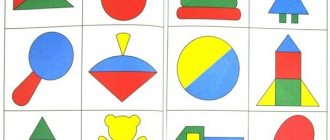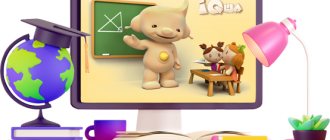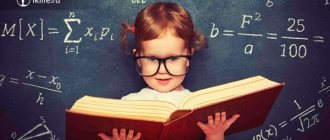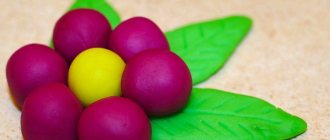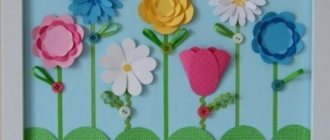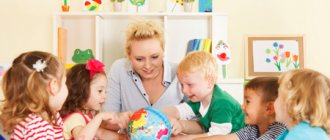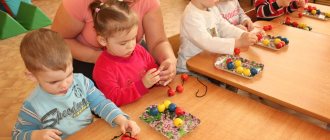The opinion that school will teach a child everything that a literate person should know and be able to do is no longer relevant for a long time.
If earlier parents believed that preparing for school deprives the child of childhood, now the majority tries to send the preschooler to preparation centers or study with him independently.
The question of how to prepare a child for school at home worries many parents.
What should a child entering first grade know?
It often happens that parents, when preparing their child for school, focus on one thing and neglect other aspects of development. Below is an approximate list of knowledge that a 6-7 year old child should have when entering school:
- own surname, first name and patronymic, surname, first name and patronymic of parents, home address, country and city of residence;
- your birthday and the birthdays of your parents;
- days of the week, months, seasons;
- names of common animals and plants;
- primary colors;
- basics of traffic rules;
- professions, sports, names of famous poets and writers;
- major holidays;
- “right” - “left”, “more” - “less”, “older” - “younger”, “long” - “short” and so on;
- how do bodies of water differ (do not confuse rivers with seas);
- what is the difference between shrubs and trees, vegetables and fruits from berries;
- how do sounds differ from letters, vowels from consonants;
- solve simple problems;
- solve logical riddles;
- restore sequence, find similarities and differences in pictures;
- describe the image, retell stories;
- know short poems;
- count to 10 and perform simple arithmetic operations;
- read small sentences (4-5 words), understand what you read;
- cut geometric shapes with scissors;
- draw straight lines without a ruler, hatch without going beyond the outline.
Preparing your child for school at home on speech development: developmental tasks
The development of speech with the baby should occur from the first months of life, when the mother monitors what sounds her baby makes. The development of a child’s speech should include several types of activities:
- Speech therapy. If there are certain problems with pronouncing certain letters and words. You should pronounce tongue twisters and do exercises for the speech apparatus.
- Games for speech development. Various games for composing phrases and sentences, guessing words.
- Phonetics games. Tasks in which the child must guess and recognize sounds in words.
- Development of the articulation and speech apparatus (help improve speech and get rid of speech therapy problems).
- Studying poetry. Increases vocabulary and develops speech, making it more coherent.
- Puppet theater games. Help the child to speak correctly.
Task No. 1
Task No. 2
Task No. 3
Tasks and games in various subjects
When preparing a child for school, parents should remember several important points:
- Classes should be conducted exclusively in a playful way. Forcing a child to study, yell at him, much less punish or beat him is unacceptable. The task of parents is to interest the child, only then will he be successful in life and win respect among friends.
- The duration of the lesson should not exceed 15 minutes; there must be a break of 20 minutes between lessons.
- Subjects should be alternated - reading with drawing, mathematics with physical education, and so on. Prolonged mental stress has a bad effect on the condition of a growing organism.
- The complexity of the material should be increased gradually; there is no need to rush with new tasks.
- It is recommended to use colorful manuals; reading texts should be interesting.
- Help your child, explain what is not clear, read good fairy tales.
Math lessons
It is advisable to teach your child to count using familiar objects – candy, toys. A little later, you can switch to counting sticks or special cards.
It is very useful to study numbers in pairs, for example, 5 apples and 1 apple, together there will be 6 apples. One such pair needs to be studied for a whole lesson, and at the beginning of the next lesson, you need to repeat the material covered, and then move on to the next pair of numbers.
geometric shapes using cookies as an example - round, square, and triangular cookies can easily be found in stores.
When the child remembers the shapes and names of the main figures, you can move on to drawing them using a ruler.
Reference! Alternation will bring more benefit - today counting, tomorrow - geometry, the day after tomorrow - solving simple examples.
Math games:
- Draw 2 houses of 3 floors, shade the windows in some of the windows of one house, and tell the child that people live in these apartments. The task is to move the same number of people into another house.
- Download number pictures in which you need to connect the numbers in the correct order with lines to make a picture.
- Draw geometric shapes and ask the child to come up with what they can be turned into. For example, a circle - a sun, several triangles - a herringbone, and so on.
Letter
Helpful Tips:
- First you need to train the child’s hand - without this, children will not be able to practice writing for a long time,
- Develop fine motor skills - let the child sort cereals (beans, pasta), do modeling,
- Cutting out various shapes with scissors prepares your hand well for writing.
First you need to teach your child to write block letters , and only when the entire alphabet has been completed can you move on to capital letters.
It is necessary to explain to the child that you need to write carefully and you cannot go beyond the stripes or squares. Of course, the handle should be comfortable, and the child should hold it correctly.
Writing assignments:
- Draw a labyrinth and let the child use a pen to draw a path out of it so that, say, the little bunny finds its mother.
- Draw a simple picture, for example, a bouquet of flowers, and let the child complete the vase for it.
These exercises will help your child learn to hold a pen more confidently.
Reading
The sooner a child learns to read, the easier it will be for him to master all other subjects.
Letters need to be learned alphabetically. They can be drawn, sculpted from plasticine, and parents must come up with an association for each letter. For example, the letter O looks like glasses, J - like a beetle, and D - like a house. If possible, you can show the letters using your fingers or torso.
After the child has learned a few letters, read a short text to him and ask him to look for letters he knows in it.
Be sure to ask what the text you read was about, ask to retell it, ask a few questions about the text.
Tasks:
- Look for a familiar word in a short text. Moreover, this needs to be done in 1 minute.
- Ask your child to read first loudly, then quietly, then silently. At the same time, you need to make sure that the pace of reading does not change. Ask your child to read without opening his teeth. After reading, the child must retell the text.
- In 30 seconds, invite the child to write as many vowels as possible, first, then consonants.
- Write the syllables on the cards and the child will make words from them.
- Play “changeling” - show your child how “cat” can turn into “current”, and “call” into “cart”.
- Write down as many words as familiar to the child and skip them one letter at a time. The child will insert them.
- Teach your child to read at speed. To visualize the improvement in speed, you can use an hourglass.
Creation
Teach your child to use markers, paints and a brush. Teach your child to shade a limited area without going beyond the boundaries. Coloring books with large and then small details will help with this.
While drawing or modeling, you can study other objects, for example, let the child make letters, or while drawing, find geometric shapes - a house is a square, its roof is a triangle, and a ball is a circle.
Preparing your child for school in reading at home: developmental tasks for children
You should educate and develop your child at home long before you are going to send him to first grade. It is important to correctly calculate the load that you can put on the baby, not to force him to study if he does not want to, to use modern techniques, visuals, and games.
Teaching reading for preschoolers can be divided into several stages:
- Preparing for training
- Learning letters
- Learning syllables
- Reading words
- Reading phrases
- Reading sentences
Preparing to learn to read is about getting your child interested. To do this you need to use game moments. The ideal age to start reading is 4 years.
How to conduct classes:
- Warm-up (articulation). You need to prepare for classes, learn to inhale and exhale air correctly (calmly and measuredly).
- Speech development exercise. Try to teach your baby to clearly pronounce letters (especially buzzing, ringing and hissing ones).
- Repetition and learning of letters of the alphabet. Be sure to demonstrate pictures and words for the letters being studied.
- Reading syllables. Starting with simple ones and ending with complex ones. You can turn this activity into a game by writing syllables on paper and drawing body parts with them.
- Reading simple and symbolic words syllable by syllable: ma-ma, pa-pa, ku-ku and so on.
Lesson No. 1
Lesson No. 2
Preparing your child for school in mathematics at home: developmental tasks
A child should be taught mathematics at an early age with the help of applied practical examples, with the participation of toys and objects (fruits, pictures, cartoons).
What tasks to use:
- Teach your child to count to 10. Use counting sticks or any other objects for this.
- Copybook "Numbers". Helps kids not only learn to count, but also remember numbers visually.
- Learn to draw and name geometric shapes . Count their number of sides, angles, sizes: large, small
- Solve simple examples of addition and subtraction : adding and subtracting: 2+1, 3-1 and others.
Math classes
Assignments for future first-graders preparation
For the comprehensive development of a child, comprehensive preparation for school is required. Basic tasks must solve the following problems:
- development of established speech (composing a story, describing an object, inventing a plot from pictures);
- attention training (tasks to identify an extra object, find differences);
- development of hand motor skills (modeling, lacing, composing figures from a construction set according to a drawing);
- creative thinking (drawing, appliqué);
- improving memory (memorizing poems, games with memorizing pictures);
- logic training (logic tests and tasks);
- reading, writing, counting (simulators, copybooks, math tests).
Preparation should take place in a playful way, which will awaken the child’s interest, cognition, non-standard thinking and logic. It is advisable to spend no more than 20 minutes on each lesson, and for work use special manuals with pictures and exciting tasks.
Preparing your child for school in writing at home: developmental tasks
There are a number of exercises for young children that help develop correct writing skills in preschoolers:
- Hatching. You can specifically purchase notebooks, copybooks and collections of exercises, or draw on blank sheets of paper. Hatching is the addition of straight, oblique, vertical or horizontal strokes to a drawing.
- Graphic dictation. This is drawing by cells. The task is to circle the exact number of cells to get a certain pattern. Each line in a cell (left, right, up, down) must be dictated by an adult.
- Mirror drawing. To do this, the child is given only half of the sketch (a human face or an animal's muzzle), which must be completed.
- Letter via carbon copy. Interests the baby and encourages him to draw every line.
- Translation of pictures through light on glass. To do this, you can use a window during the daytime, and a glass table and lamp in the evening. The activity develops in the child the desire to lead a straight line.
- Stroke. The child needs to circle the drawing along the dotted line and get a picture.
- Trace by numbers. It is necessary to circle the numbers strictly in the correct order to get the picture.
- Work in copybooks. Each mother can do them on her own or purchase a ready-made notebook with tasks.
Task No. 1
Task No. 2
Task No. 3

